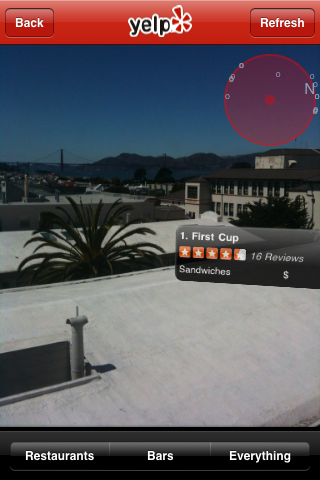 Editor’s Note: This guest post was written by Matt Galligan, CEO of CrashCorp, a company working on a product called SimpleGeo providing “location as a service” as well as an Augmented Reality SDK for app developers. (We covered their founding here.) As such, Galligan clearly has a stake in the AR game, but he was genuinely surprised by the revelation of the AR element to the Yelp app update yesterday. You can follow Matt on Twitter here.
Editor’s Note: This guest post was written by Matt Galligan, CEO of CrashCorp, a company working on a product called SimpleGeo providing “location as a service” as well as an Augmented Reality SDK for app developers. (We covered their founding here.) As such, Galligan clearly has a stake in the AR game, but he was genuinely surprised by the revelation of the AR element to the Yelp app update yesterday. You can follow Matt on Twitter here.
Yelp has had no shortage of hullabaloo surrounding the most recent improvement to its iPhone app. Rightfully so, it added an Augmented Reality view for its restaurant reviews. Using the AR view, users of the Yelp app can pan around using their camera, and see information overlaid, presumably, on top of the restaurant of their query, garnering review information. While this functionality is certainly useful, and nothing short of excellent eye candy, could there be a thorn with this rose?
Augmented Reality has been all the rage with app developers recently, originally employing unreleased SDK features to build the technology. However, in recent months, it was discovered that the new iPhone OS 3.1 upgrade changed the camera functionality in a way that would enable app developers to build their Augmented Reality views in a more sanctioned environment. This development has been a shot in the arm for AR developers, and there seems to be many implementations being built. However, it was understood that the world would have to wait for AR on the iPhone, at least until iPhone OS 3.1 was released. That was, until, Yelp’s most recent iPhone app got approved in the store with an easter egg that, after shaking the device three times, enabled an Augmented Reality view.
Call it sneaky, call it clever, but I call it deceit. Apple has put forth specific guidelines, and “rules” around their app development, and while I don’t always agree, it’s the reality of how we must work with them for now. Yelp hid their easter egg behind shaking the device, which isn’t always the most intuitive action to take on an app that contains some maps and lists. As a result, the unsanctioned Augmented Reality view was gone from Apple’s radar. The same would seem to be true with a couple other applications that snuck in AR features as updates to their apps. As recently as last month, Apple was telling developers making AR apps that they would have to wait for iPhone 3.1. It was only after approval, that Yelp announced that the functionality existed. There was palpable excitement around the Yelp’s announcement (and the other apps), having been the first AR apps to be approved, but something smelled afoul.
My concern is that Yelp has set an awful precedent by this act. Now, every app developer will likely undergo even more scrutiny. Accessing private API’s goes against the agreement every iPhone developer has to abide by when submitting applications to the App Store. By subverting this agreement through an “easter egg”, Yelp could very well cause the approval process to become more draconian. Whereas before, Apple was primarily looking for trademark violations, “correct” usage of their Human Interface Guidelines, and show-stopping bugs, they’ll now have to go over each app with fine-toothed comb to make sure no feature that is likely to be unsanctioned will be released. Now granted, this may also be seen as a big cry for openness in the App Store, but so long as the App Store approval process remains in the status quo, deceitful acts like this won’t continue to go unnoticed by them.
The implications are simple: a longer wait time for apps to be approved, longer time for bug fixes and overall, a poorer experience for developers and users both. While I hope for a less strict App Store, so long as that’s not the case, I hope more that developers stick to more of the straight and narrow (read: not so shady tactics) so they don’t ruin it for the rest of us.